1:30min
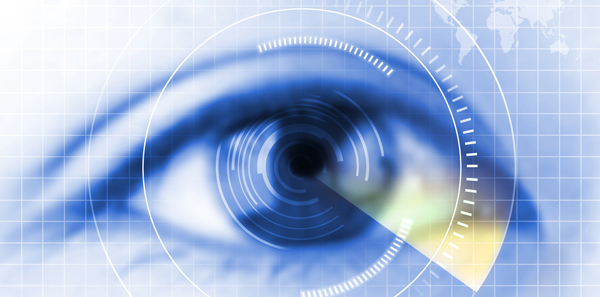
Professor Emeritus Nathan Efron
AC DSc PhD BScOptom FAAO(Dip CCLRT) FCCLSA FACO
Professor Emeritus, Institute of Health and Biomedical Innovation, and School of Optometry, QUT, Brisbane, Australia
Professor Philip B Morgan
PhD
Director, Eurolens Research, the University of Manchester, Manchester, UK
Professor Craig A Woods
PhD
School of Medicine (Optometry), Deakin University, Geelong, Australia
The 19th annual survey of Australian contact lens prescribing was conducted between January and April, 2018.
The same format as in previous years was employed. An email was sent to all members of Optometry Australia with a link to a questionnaire, and a request that this be downloaded, printed and completed to provide details of the first ten patients fitted with contact lenses after receipt of the questionnaire. The survey was specifically designed to be straightforward for optometrists to complete while capturing key information about their patients.
Practitioners were asked general questions about themselves. For each contact lens fitting, they were requested to complete the following details: date of fitting, new fitting or refitting, age and sex of patient, lens material, lens design, frequency of replacement, times per week of wear, modality (daily or extended wear) and care system. Practitioners were asked to return the photographed or scanned copies of the questionnaire by email.
Completed questionnaires relating to 381 contact lens fits were returned, which provides a sound basis for a meaningful analysis. Each fitting was given an annualised weighting based on the number of lenses fitted during the survey period and the time taken to complete the fits. This means that data generated by practitioners with a higher frequency of fitting contact lenses were afforded a higher weighting than those with a lower frequency of fits.
The discussion below will concentrate primarily on data relating to new lens fits, as opposed to refits. We believe that new fits are a more sensitive barometer of current patterns and future trends, whereas refits are more indicative of previous fitting behaviours.
In keeping with other markets around the world,1 a majority of lenses (69 per cent) were fitted to females. The average age of contact lens wearers at the time of fitting was 40.2 ± 16.9 years. The age at fitting ranged from eight to 79 years. This is the first time that the average age at fitting in Australia has exceeded 40 years, and reflects a continual year-on-year increase. In 2000, the average age was 32 years.
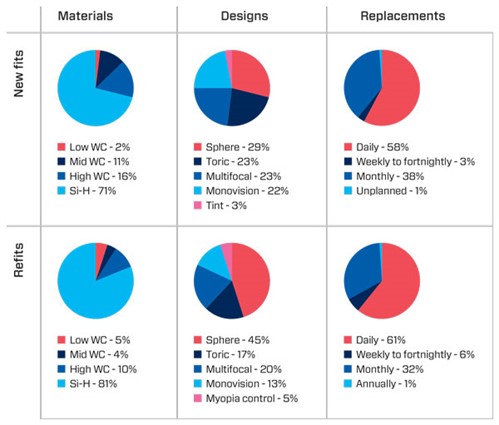
Figure 1. Detailed results for soft contact lens prescribing in the 2018 Australian survey (Si-H, silicone hydrogel; WC, water content)
Soft lens materials and designs
Soft lenses are still the main type of contact lens fitted, accounting for 87 per cent of new fits, representing a slight decrease from the last few years.2
Figure 1 is a composite of pie charts detailing the key findings of the 2018 survey in relation to soft lenses. Silicone hydrogels are still the dominant material, representing 71 and 81 per cent of materials prescribed as new fits and refits, respectively, with the balance comprising a mixture of low-, mid- and high-water content hydrogel materials. The remarkable penetration of silicone hydrogel materials since their introduction into the market at the turn of the century is illustrated in Figure 2. The reason for the popularity of this highly-oxygen-permeable material type is that it essentially eliminates hypoxic complications such as limbal and conjunctival redness, stromal oedema, corneal neovascularisation and epithelial microcysts.3
The key categories of lens designs are spherical, toric, multifocal, monovision, coloured (tinted) and myopia control. Spherical designs represented 29 per cent of new fits. Almost a quarter of soft lenses prescribed are in toric form (Figure 1).
Figure 3 shows trends in the proportion of toric lens fits as a proportion of all spherical and toric lens fits, since 2000. The gradual increase in toric lens fitting can be attributed to a combination of better toric lens designs being introduced—making such lenses easier to prescribe and fit—and a growing range of available toric parameters. The level of toric lens prescribing in Australia has consistently fallen short of that which would be expected if all lens wearers with greater than or equal to 0.75 D of astigmatism were fitted with toric lenses (shown by the dotted line in Figure 3).4,5
The slight decline in toric lens prescribing between 2013–2016, as can be seen in Figure 3, was possibly due to accelerated prescribing of silicone hydrogel daily disposable lenses during this period, with the availability of toric designs lagging behind spherical designs for this lens type. As the data for 2017 and 2018 shows, this situation has now been rectified, with a wide range of parameters now available in toric silicone hydrogel daily disposable lenses and a commensurate increase in toric lens fitting.
Multifocal designs continue to be preferred to monovision for the correction of presbyopia. This trend, which has been evident since the turn of the century, can be attributed to improved multifocal lens designs. The fact that almost a quarter of soft lens fits are for the correction of presbyopia highlights the importance of this demographic in modern day contact lens practice. No doubt this will be a growing proportion of the market as pre-presbyopes fitted during the big growth period for contact lenses in the 1990s and 2000s advance towards manifest presbyopia. Indeed, this trend is consistent with the overall increase in the average age of lens wearers, as discussed above. Also, the possible future introduction of multifocal designs in toric form will likely boost the fitting of multifocal lenses.
As was the case in 2017, coloured (tinted) lenses only represented one per cent of new fits this year. Myopia control lenses incorporate special designs for arresting the rate of progression of myopia.6 Although these lenses represented one per cent of new fits and two per cent of refits in 2017,2 very few (0.2 per cent) new fits were recorded this year, although the proportion was greater for refits (five per cent). The small number of new fits might reflect the current paucity of specific lens designs for myopia control available in Australia and/or an overly cautious approach of contact lens practitioners who desire more evidence of the efficacy of such lenses.
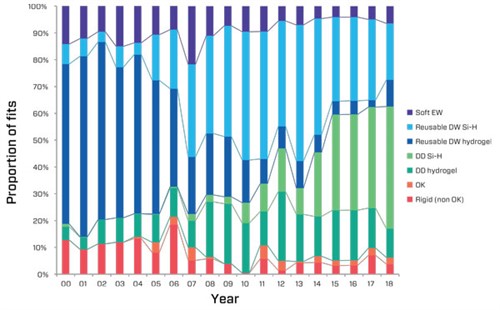
Figure 2. Proportion of all fits of various lens categories in Australia between 2000 and 2018 (EW, extended wear; DW, daily wear; Si-H, silicone hydrogel; DD, daily disposable; OK, orthokeratology)
Soft lens replacement and wearing modality
Virtually all soft lenses are replaced daily (62 per cent) or monthly (34 per cent). Trends since 2000 in daily disposable versus reusable soft lens fitting, in both hydrogel and silicone hydrogel materials, are shown in Figure 2. Daily disposable lenses, especially those made from silicone hydrogel materials, now dominate the market. As noted in our report last year, if this rate of prescribing daily disposable lenses continues at the same rate as has been apparent so far this century, virtually all soft lenses prescribed in Australia may be this lens type in the very near future.
Extended wear lens fitting, almost exclusively with silicone hydrogel materials, has remained constant at around eight per cent of all lens fits over the past decade (Figure 2).
Multi-purpose solutions remain the lens care option of choice for those wearing reusable lenses, representing 87 per cent of prescribed care regimens. The balance is made up almost exclusively of peroxide systems.
Rigid lenses
Of all rigid lenses prescribed, 39 per cent were orthokeratology fits. The slight increase in rigid lens prescribing in 2018 compared with recent years2 perhaps reflects a renewed interest in large diameter rigid lenses and orthokeratology for temporary myopia relief and/or myopia control.
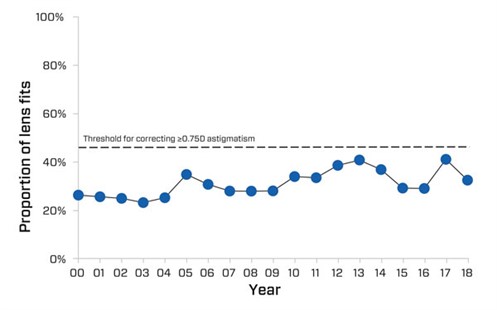
Figure 3. Percentage of all soft lenses prescribed as toric lenses in Australia between 2000 and 2018
Australia versus the UK
We have conducted annual contact lens fitting in about 40 countries over the past few years.1 This provides an opportunity to benchmark against international colleagues, and this year we compare contact lens prescribing in Australia against the UK (Figure 4). Seven key categories of lens type are represented. The outer and inner rings display the Australian and UK fitting data,1 respectively.
Similar prescribing trends might be expected in Australia and the UK, in that both countries: (a) are island nations that are often used as ‘test beds’ by industry for trialling new products, (b) are dominated by large practice chains (with one major chain operating in both countries); (c) have a sophisticated base of registered practitioners with advanced university-based training; (d) have active contact lens organisations (the Cornea and Contact Lens Society of Australia and the British Contact Lens Association); and (e) have strong sales and marketing representation from the four major international contact lens corporations.
Indeed, inspection of Figure 4 confirms broad similarities between contact lens fitting in Australia and the UK. Although the overall extent of silicone hydrogel lens fitting is similar, Australian practitioners prefer to fit a higher proportion of daily disposable lenses made from this material. Whereas virtually all soft lenses were reusable hydrogel lenses towards the end of the 20th century, this modality now represents only 10 and four per cent, respectively, of all lens fits in Australia and the UK, although the reason for this difference between nations is not clear. More orthokeratology lenses are fitted in Australia, but the rate of fitting of other rigid lens types is similar.
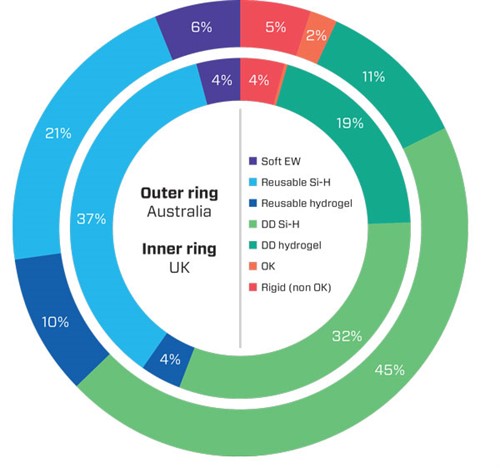
Figure 4. Percentage of all contact lenses prescribed in Australia (outer ring) compared with the UK (inner ring) (EW, extended wear; DW, daily wear; Si-H, silicone hydrogel; DD, daily disposable; OK, orthokeratology)
Conclusions
The results of our 2018 survey indicate an increase in the average age of lens wearers and a high rate of prescribing daily disposable lenses in Australia. Silicone hydrogels are very firmly entrenched as the material of choice, representing around 78 per cent of all soft lens fits. High levels of contact lens fitting for presbyopia (especially multifocals), and astigmatism, continue at similarly high levels as have been observed since the turn of the century.
1. Morgan PB, Woods CA, Tranoudis IG, et al. International contact lens prescribing in 2017. Contact Lens Spectrum 2018; 33 (1): 28-33.
2. Efron N, Morgan PB, Woods CA. Contact lens prescribing trends 2017. Pharma 2017; December: 2-4.
3. Efron N. Contact Lens Complications. 4th edition. Edinburgh: Elsevier, 2019.
4. Holden BA. The principles and practice of correcting astigmatism with soft contact lenses. Aust J Optom 1975; 58: 279-299.
5. Young G, Sulley A, Hunt C. Prevalence of astigmatism in relation to soft contact lens fitting. Eye Contact Lens 2011; 37: 20-25.
6. Sankaridurg P. Contact lenses to slow progression of myopia. Clin Exp Optom 2017; 100: 432-437.
______________________________
Tagged as: Contact lenses, Pharma